![]()
![]()
![]()
Use LEFT and RIGHT arrow keys to navigate between flashcards;
Use UP and DOWN arrow keys to flip the card;
H to show hint;
A reads text to speech;
32 Cards in this Set
- Front
- Back
|
budget line/constraint |

all possible combinations of 2 goods that may be purchased with entire budget
M ≥ Px*X + Py*Y
opportunity set is area under line, all consumption possibilities w/in budget limits |
|
|
cardinal vs ordinal utility |
cardinal is hypothetical numerical values (utils)
ordinal is based on ranking goods in order of preference |
|
|
indifference curve |
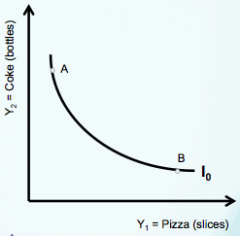
curve of all combinations of 2 good consumptions with same utility/satisfaction level
1. downward slope 2. complete 3. can't intersect 4. convex to origin |
|
|
MU |
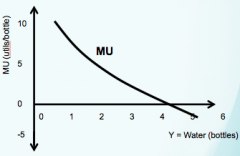
marginal utility
change in level of utility with consumption of one additional unit of a good
∆TU/∆Y |
|
|
TU |
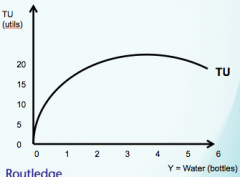
total satisfaction from consuming certain goods and services |
|
|
consumer behavior (assumptions) |
1. complete preference (always 1 good over the other)
2. consistent preference (always prefer the same thing over another thing)
3. nonsatiation (always want to consume more) |
|
|
law of diminishing marginal utility |
MU declines as more of a good or service is consumed in given time period (as increasingly more satisfaction is reached)
typically decreases the most after the first unit consumed |
|
|
complements |
goods that are either consumed or produced together |
|
|
perfect complements |
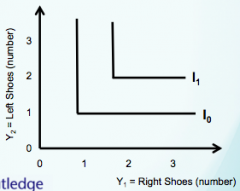
goods that must be consumed in a fixed ratio |
|
|
substitutes |
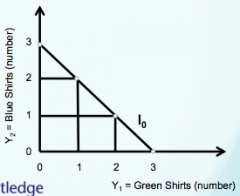
goods consumed either/or
compete for same resources in production |
|
|
MRS |
marginal rate of substitution
rate of exchange of one good for another leaving utility unchanged
∆Y2/∆Y1 |
|
|
consumer equilibrium |

where slope of indifference curve = slope of budget line MRS = price ratio ∆Y2/∆Y1 = -P1/P2 -MU1/P1 = MU2/P2 |
|
|
elasticity |
% change in one economic variable with respect to the % change in another economic variable |
|
|
elasticity of supply
inelastic supply curve
elastic supply curve
unitary elastic supply curve |
%∆Qs / %∆P unitless, becomes more elastic as time passes
unresponsive to changes in price (Es < 1)
responsive to changes in price (Es > 1)
change in price means equal change in quantity supplied (Es = 1)
|
|
|
own-price elasticity of supply |
∆Qs in response to ∆P of that good |
|
|
cross-price elasticity of supply |
∆Qs in response to ∆P of a related good |
|
|
change in supply |
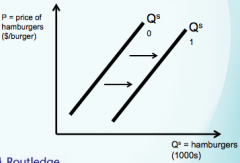
∆Qs due to change in another economic variable other than price of that good
shift of the entire supply curve |
|
|
change in quantity supplied (Qs) |
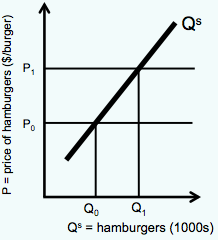
when ∆Qs is in response to ∆P of the good
movement along a supply curve |
|
|
demand curve |
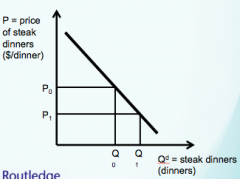
all possible combinations of prices and quantities consumed for a good, ceteris paribus''
market demand curve - sum of all horizontally |
|
|
Law of Supply
vs.
Law of Demand |
Q goods offered varies directly with P good
Q good demanded varies inversely with P good |
|
|
price elasticity of demand
inelastic demand curve
elastic demand curve
unitary elastic demand curve |
%∆Qd / %∆P
1% change P means relatively smaller %change Qd (|Ed| < 1)
relatively larger % change Qd (|Ed| > 1)
(|Ed| = 1) |
|
|
own-price elasticity of demand |
change in Qd in response to changes in P of same good |
|
|
cross-price elasticity of demand |
change in Qd in response to changes in P of a related good |
|
|
change in quantity demanded |
result of change in price of a good
movement along the demand curve |
|
|
change in demand |
change in economic variable other than P good
shift in the entire demand curve
|
|
|
Engel's Law |
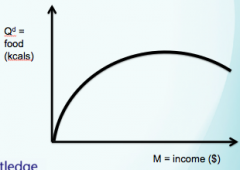
as income increases, proportion of income (M) spent on food declines |
|
|
income elasticity of demand (Em) |
%∆Qd / %∆M
change in demand from change in income |
|
|
normal good
inferior good
luxury good
necessity good |
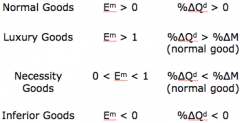
consumption increases with income rise (Em > 0)
consumption declines with income rise (Em < 0)
C increases at increasing rate with M (Em > 1)
C increases at decreasing rate with m (0
|
|
|
supply |
relationship between price of a good and quantity available
determinants: 1. input prices, 2. technology, 3. prices of related goods, 4. number of sellers
|
|
|
supply curve for individual firm |

MC above the AVC curve |
|
|
determinants of demand |
own price P related goods M (Income) tastes and preferences expected prices population |
|
|
shift in supply |
change in supply (movement whole supply curve) change in quantity demanded (movement along demand curve) |

